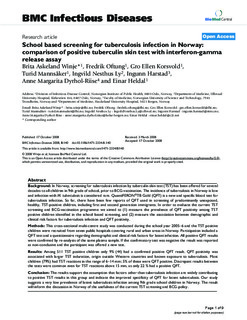School based screening for tuberculosis infection in Norway: comparison of positive tuberculin skin test with interferon-gamma release assay
Winje, Brita Askeland; Oftung, Fredrik; Korsvold, Gro Ellen; Mannsåker, Turid; Ly, Ingvild Nesthus; Harstad, Ingunn; Dyrhol-Riise, Anne Ma; Heldal, Einar
Journal article, Peer reviewed
Permanent lenke
http://hdl.handle.net/11250/2358276Utgivelsesdato
2008Metadata
Vis full innførselSamlinger
Sammendrag
Background: In Norway, screening for tuberculosis infection by tuberculin skin test (TST) has been offered for several
decades to all children in 9th grade of school, prior to BCG-vaccination. The incidence of tuberculosis in Norway is low
and infection with M. tuberculosis is considered rare. QuantiFERON®TB Gold (QFT) is a new and specific blood test for
tuberculosis infection. So far, there have been few reports of QFT used in screening of predominantly unexposed,
healthy, TST-positive children, including first and second generation immigrants. In order to evaluate the current TST
screening and BCG-vaccination programme we aimed to (1) measure the prevalence of QFT positivity among TST
positive children identified in the school based screening, and (2) measure the association between demographic and
clinical risk factors for tuberculosis infection and QFT positivity.
Methods: This cross-sectional multi-centre study was conducted during the school year 2005–6 and the TST positive
children were recruited from seven public hospitals covering rural and urban areas in Norway. Participation included a
QFT test and a questionnaire regarding demographic and clinical risk factors for latent infection. All positive QFT results
were confirmed by re-analysis of the same plasma sample. If the confirmatory test was negative the result was reported
as non-conclusive and the participant was offered a new test.
Results: Among 511 TST positive children only 9% (44) had a confirmed positive QFT result. QFT positivity was
associated with larger TST induration, origin outside Western countries and known exposure to tuberculosis. Most
children (79%) had TST reactions in the range of 6–14 mm; 5% of these were QFT positive. Discrepant results between
the tests were common even for TST reactions above 15 mm, as only 22 % had a positive QFT.
Conclusion: The results support the assumption that factors other than tuberculosis infection are widely contributing
to positive TST results in this group and indicate the improved specificity of QFT for latent tuberculosis. Our study
suggests a very low prevalence of latent tuberculosis infection among 9th grade school children in Norway. The result
will inform the discussion in Norway of the usefulness of the current TST screening and BCG-policy.
